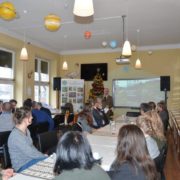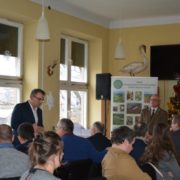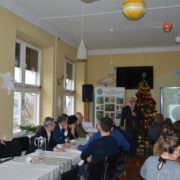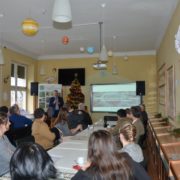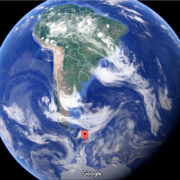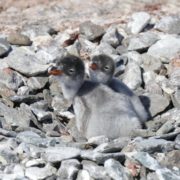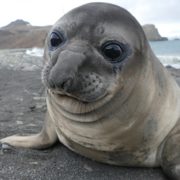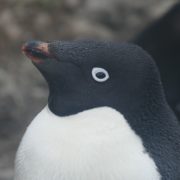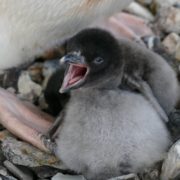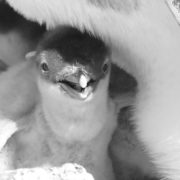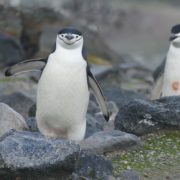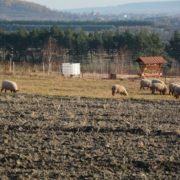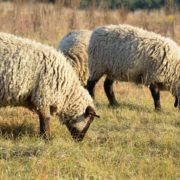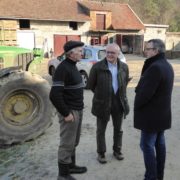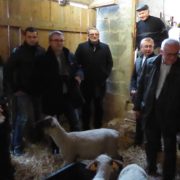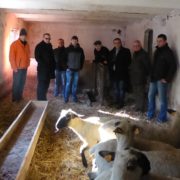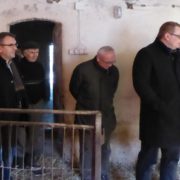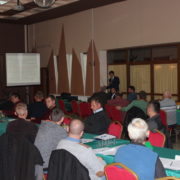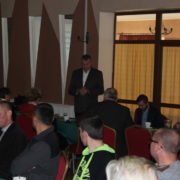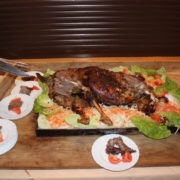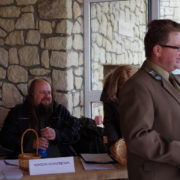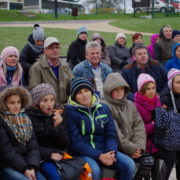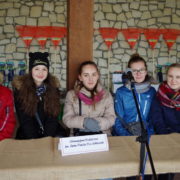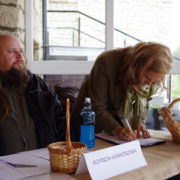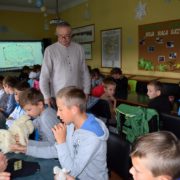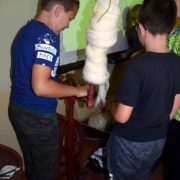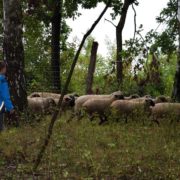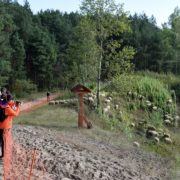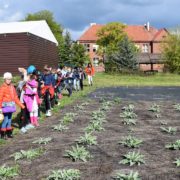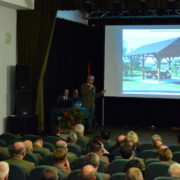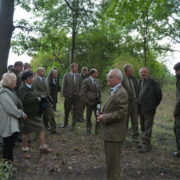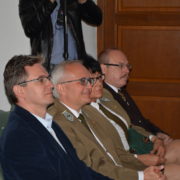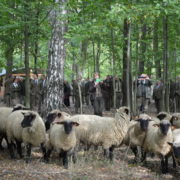News
The Nativity scene in Pińczów
This year, at Christmas, in the Holy Mother Sanctuary in Pińczów, you could admire the Nativity scene located at the courtyard of the Franciscan Monastery. The place had been chosen because of St Francis, who on the 24th of December 1223, in Greccio, had organized the first Nativity scene in the world. In Poland, this tradition was initiated at the close of the 13th century by the Franciscan Order.
In Pińczów, the Nativity scene was organized for the first time. It was very popular with the inhabitants, who visited the monastery with their whole families. It was also a great opportunity to promote our project, as the blackhead sheep, which had come to Ponidzie under the LIFE13 NAT/PL/000038 project “The protection of habitats of great natural interest at the Ponidzie region”, were among the participating animals.
Pasturing flocks on xerothermic grasslands is a way to protect them, but also a tourist attraction, as sheep are very popular, especially with children.
A session of the Steering Committee
On the 15th of December, in the headquarters of the Landscape Park Complex of the Świętokrzyskie and Nadnidziańskie Region, there was a session of the Steering Committee for the LIFE13/NAT/PL/000038 project. The participants of the meeting included farmers pasturing their flocks on the grasslands covered by the project, as well as other invited guests, including Piotr Żołądek, representing the Management Board of the Świętokrzyskie Region. In a short presentation, Wojciech Sołtysiak, the project manager, showed the project progress and all the activities taken from March 2015. We also informed the Steering Committee that our activities had been approved by the European Commission, which had endorsed the interperiod report.
The essence of LIFE projects is their stability and the continuation of protective activities after the formal ending of the project. In order to make the most of the opportunities for the development and promotion of the Ponidzie region while carrying out our project, we had also invited two lecturers to the meeting. Professor Tadeusz Zając (Polish Academy of Sciences) in his lecture pointed out the natural potential of Ponidzie as well as the potential for tourism development and the possibility of earning money from natural attractions, whereas Ph.D. Andrzej Junkuszew from the University of Life Sciences in Lublin presented the economic, natural and cultural advantages of sheep breeding, and he also shared his experiences in promoting lamb’s meat coming from areas of great natural interest, which had been carried out in the Lubelskie Region.
After the official part, we had some time to talk and to taste lamb (this time not from Ponidzie yet), and, as Christmas was coming, also to give our best wishes to one another and to sing carols.
Our people in the Antarctic!
We received personal greetings, and our T-shirt advertising the protection of xerothermic grasslands travelled over 14 thousand kilometres to the place where the average annual temperature is minus 2 degrees, that is, to the Henryk Arctowski Polish Antarctic Station on King George Island at the South Shetland Islands. The participants of the 41st Antarctic expedition have been working there for six weeks. The team includes Damian Czajka, an ornithologist from the MOST Association, who worked with us on carrying out projects regarding the protection of Gliridae species and bats. Damian Czajka participates in the expedition as a paramedic, and he is also helping with the environmental monitoring to estimate of the size and condition of the population of sea birds and pennipedians. As he wrote in his email to us, “During our daily observations in the field we gather information about the location of bird nesting places, the number of nests, that is, nesting pairs, and the number of fledglings, which allows us to estimate the size of the population and their breeding success. In order to determine the condition of the birds in due time we weigh and measure eggs and fledglings. Every 10 days we monitor 9 km of the coast to estimate the number of seals and sea lions. In the breeding season, we record the number of the young animals born of these species, as well as their survival rate”.
The meteorological, glaciological and ecological monitoring conducted in the area of the Station allows them to track climate changes and transformations in the sea ecosystems. Based on this information, e.g. fishing limits are determined. At present, in the Antarctic, there are 40 all-year-round stations and 41 stations only open in summer. More information about work at the station can be found at www.arctowski.pl
When the herding?
Although the time of the customary herding already passed on the 29th of September, the sunny weather allowed our sheep to go to work again to their Ponidzie pastures. The chances are that the pasture this year would be exceptionally long to the breeders’ delight, and to the satisfaction of the LIFE + team. In the ending season, our blackhead sheep have done a lot of protective work, the first effects of which would certainly be visible in the following year.
In the photos by Włodek Rudolf, you can see sheep from Grzegorz Szymański’s farm on the hills at Skowronno near Pińczów.
The end of the pasturing season
Michał Dobaj’s farm, which we visited during the symbolic ending of the pasturing season, is one of the six farms working with the Landscape Park Complex of the Świętokrzyskie and Nadnidziańskie Region on carrying out the LIFE+ project “The protection of xerothermic grasslands at the Ponidzie region”. The sheep, which were working on the grasslands for the whole summer as natural mowers, have already returned to the sheepfold for winter. The first pasturing season has ended. We are waiting for the birth of lambs, which will set off to the pastures near the Nida River in the spring. The presence of a member of the Management Board of the Świętokrzyskie Region, Piotr Żołądek, and several breeders was an opportunity to discuss the possibilities of sheep breeding development at the Ponidzie region.
Sheep pasturing on the grasslands have already become a tourist attraction. This ecological and extensive breeding model, and the increase of the headage of the flocks in the future, will result in lamb production. Lamb has extraordinary dietary values due to the content of polyunsaturated fatty acids as well as orotic acid and linoleic acids, which are strong antioxidants. In the future, lamb dishes can become a distinctive feature and an attraction of the Ponidzie region in the same way as the St Anne’s Chapel or the Wielopolski Palace in Chroberz.
Training for shepherds organized by the Świętokrzyski Agricultural Extension Centre (ŚODR) in Modliszewice
All the six breeders working with us on the project regarding the protection of xerothermic grasslands participated in the training for shepherds organized by ŚODR in Modliszewice. For two days (October 25th and 26th), we could make ourselves familiar with “Innovative methods of breeding small ruminants”. The title of the conference fully reflected the subjects of the lectures given by scientists from the University of Agriculture in Cracow, University of Life Sciences in Lublin and representatives of the National Veterinary Inspectorate and ŚODR in Modliszewice. The training included everything the breeder could be interested in; from the construction of the sheepfold and modern technologies of the flock expansion, through the methods of feeding and breeding so as to achieve the best possible breeding results, and in the end financial results too.
A lecture on the nutritional values of milk and sheep’s meat was an opportunity to discuss the necessity of promoting lamb and using it more frequently in our menu. This meat is considered to be functional food, recommended particularly for small children, pregnant women and elderly people, as well as for convalescents. Lamb has the least cholesterol content of any meats, contains the most polyunsaturated fatty acids, and it also contains conjugated linoleic acid (CLA) stimulating the immune system. This is probably why sheep do not have cancer. The values of sheep’s meat are improved thanks to pasture feeding, i.e. what we we carry out on our xerothermic grasslands. Perhaps soon we will have a regional dish like “a leg of blackhead lamb”, which will be an additional attraction of the Ponidzie region.
A contest in Kije
The final of the contest organized by the employees of the Life+ project together with the Local Government Institution of Culture Kasztelania in Kije was held on Sunday, 16 October 2016, at the Kasztelania complex.
The middle school pupils from Sobków, Michałów and the home team took part in the competition. The members of the jury were Dr. Wojciech Szymański, the author of the questions, Magdalena Skrzypek, and Dariusz Wiech.
In the two-stage contest, the participants first had to describe one of the drawn plants and then answered short, previously drawn questions. The pupils from Michałów and Sobków showed particularly good knowledge. In the end, the pupils from Michałów turned out to be a bit better, outdistancing the Sobków team.
The home team took the third place, and they said they would try to win in the following year.
All the teams received valuable prizes, which were gardener sets. The contest was ended with a bonding meeting with hot tea and delicious żurek (soup made from fermented rye flour) cooked with the use of wild growing plants. The happy pupils said goodbye exclaiming: “See you next year”.
A preventive patrol
On Thursday, October 13th, after a few rainy days, it cleared up a bit and we could go out on patrol in the western part of Garb Pińczowski, which had been planned for several weeks. This time we were accompanied by a group from the Youth Fostering Centre in Chęciny. It was cloudy, cold and windy, but the Nida valley was quite well visible, and we could also watch kestrels circling near the Skowronno reserve, through binoculars. The participants had an opportunity to listen to a short lecture on the geology and biology of the region, but picking splendid wild mushrooms on our way was even more attractive. We did not find any illegal rubbish dumps, and after going down to Brzeście, the patrol was ended with a bonfire at the ZŚiNPK premises in Krzyżanowice.
An educational workshop
For the fourth time already, we organized a series of educational workshops for children and teenagers. For five days young people from 12 educational institutions, more than 200 people altogether, had a good opportunity to learn about the goals and realization of our project, this time under the following banner: “Sheep and goats grazing, or the protection of valuable natural habitats at Ponidzie” (“Owce i kozy na wypasie czyli ochrona cennych siedlisk przyrodniczych na Ponidziu”). The classes also included field activities, which was visiting two habitats: xerothermic grasslands at the Serpentyna site, in the closed quarry at the area of Garb Pińczowski, and in the Quercetalia pubescenti-petraeae areas in Młodzawy. Then the participants of the workshop went to the headquarters of the Landscape Park Complex of the Świętokrzyskie and Nadnidziańskie Region in Krzyżanowice to listen to a talk about the geological structure of the Nida Basin, and about customs related to sheep breeding and benefits of this. They could try their hands at spinning threads from wool, weaving on bardko (the simplest loom), or making pompons by themselves. Thanks to this, they could appreciate skills and patience needed to weave a rug or knit a sweater. This practical knowledge had once been common and necessary to live, but today, unfortunately, it is becoming forgotten. The Krzyżanowice workshop was a great opportunity to recollect it.
A meeting of foresters in Pińczów
The conference dedicated to the protection of valuable natural habitats located within the area of the Regional Directorate of National Forests, organized by the Świętokrzyskie and Radom branch of the Polish Forest Association, together with our institution, was held last Thursday in Pińczów. One of the four lecturers was our director, Mr Tomasz Hałatkiewicz, who talked about the active protection of valuable natural habitats, using an example of our Life+ project. An important item on the conference programme was a trip to the forest of the Forest Inspectorate of Pińczów, to the place where we are carrying out a program of the protection of Quercetalia pubescenti-petraeae areas, together with the Forest Inspectorate. The participants could see the effectiveness of the protective measures carried out there. This part of the conference, as well as a coach trip along the area of Garb Pińczowski, where the effects of our sheep’s work were also watched, was conducted by Mr Hałatkiewicz. The organization of the meeting of Świętokrzyskie foresters proved that we were a professional team that could rise to the challenge, which was emphasized by the forests and guests of the conference as they were leaving Pińczów, including Marshal Adam Jarubas and poet Adam Ochwanowski, one of the authors of “Ponidzie on earth” (“Ponidzie na ziemi”) diaporama, the presentation of which was the first item of the meeting in Pińczów.
















